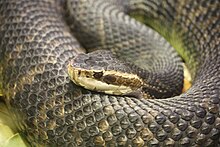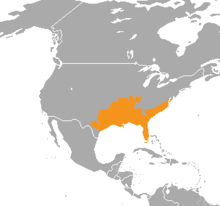Cottonmouth
| Agkistrodon piscivorus | |
|---|---|
 |
|
| Scientific classification | |
| Kingdom: | Animalia |
| Phylum: | Chordata |
| Class: | Reptilia |
| Order: | Squamata |
| Suborder: | Serpentes |
| Family: | Viperidae |
| Genus: | Agkistrodon |
| Species: | A. piscivorus |
| Binomial name | |
|
Agkistrodon piscivorus (Lacépède, 1789) |
|
 |
|
| Synonyms | |
|
click to expand
|
|
Agkistrodon piscivorus is a venomous snake, a species of pit viper, found in the southeastern United States. Adults are large and capable of delivering a painful and potentially fatal bite. When threatened, they stand their ground by coiling their bodies and displaying their fangs. Although their aggression has been exaggerated, individuals may bite when feeling threatened or being handled. This is the world's only semiaquatic viper, usually found in or near water, particularly in slow-moving and shallow lakes, streams, and marshes. The snake is a strong swimmer and has even been seen swimming in the ocean. However, it is not fully marine, unlike true sea snakes. It has successfully colonized islands off both the Atlantic and Gulf coasts.
The generic name is derived from the Greek words ancistro (hooked) and odon (tooth), and the specific name comes from the Latin piscis (fish) and voro (to eat); thus, the scientific name translates into "hooked-tooth fish-eater".Common names include variants on water moccasin, swamp moccasin, black moccasin, cottonmouth, gaper, or simply viper. Many of the common names refer to the threat display, where this species will often stand its ground and gape at an intruder, exposing the white lining of its mouth. Three subspecies are currently recognized, including the nominate subspecies described here.
This is the largest species of the genus Agkistrodon. Adults commonly exceed 80 cm (31 in) in length; females are typically smaller than males. Total length, per one study of adults, was 65 to 90 cm (26 to 35 in). Average body mass has been found to be 292.5 to 579.6 g (10.32 to 20.44 oz) in males and 201.1 to 254.1 g (7.09 to 8.96 oz) in females. Occasionally, individuals may exceed 180 cm (71 in) in length, especially in the eastern part of the range.
...
Wikipedia

